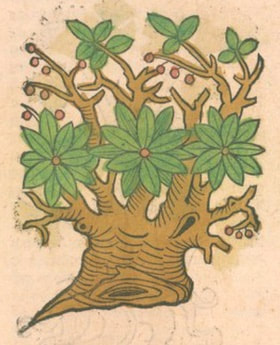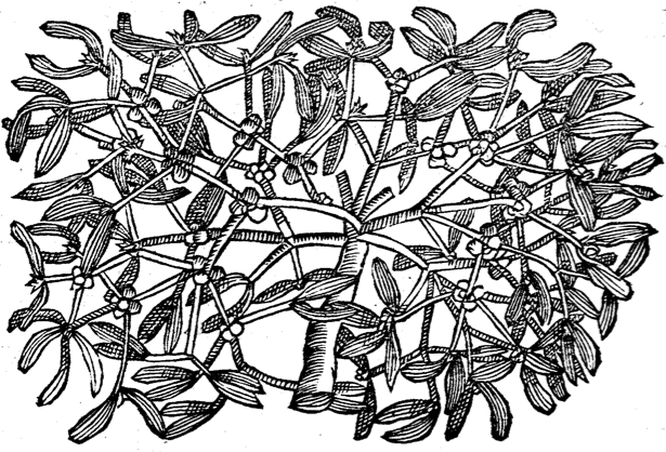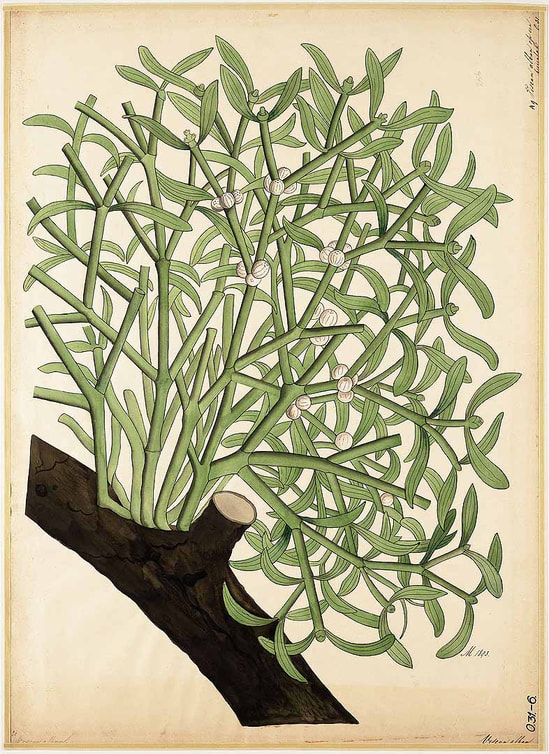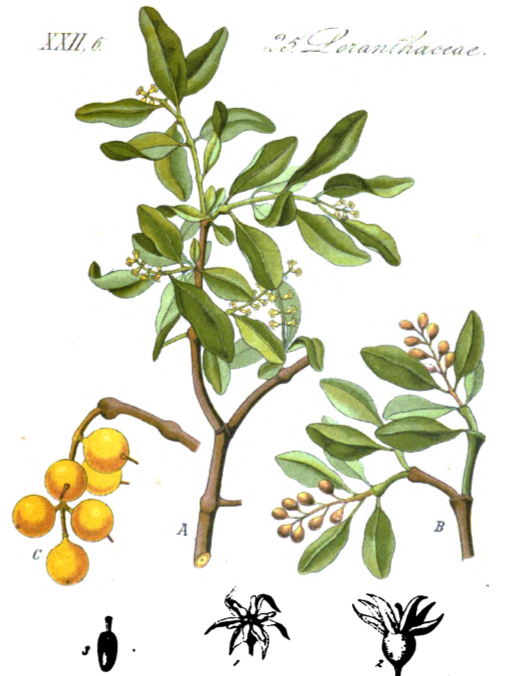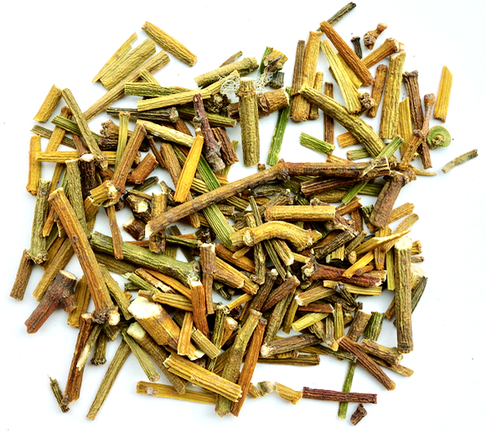Sentry Page Protection
Mistletoe (Dioscorides Materia Medica, Mathias, 1563)
Viscum
Botanische wandplaten, 1904–1914
Botanische wandplaten, 1904–1914
|
Viscum album
Koehler's Medizinal Pflanzen, 1887 |
Loranthus europeaus
Flora von Deutschland (27), Kohler, 1886 |
Viscum (Adam, 2017)
Botanical name:
Viscum, Loranthus and other species:
One study found that over 50 species of Mistletoe used in various cultures showed remarkable similarity in their traditional uses.
There are over 1000 species of Loranthus and over 550 species of Viscum.
Parts used:
Leaf and young Twigs; in TCM the whole plant including the wood is used.
Temperature & Taste:
Neutral, Bitter, Sweet.
Classifications:
2I. ANTISPASMODIC. 2L. EMOLLIENT. 2U. SUPPURATIVE
3M. ARTHRITIC
4j. NERVINE
Viscum, Loranthus and other species:
- Viscum album (Europe)
- Viscum album subsp. Coloratum (syn. V. coloratum) (TCM)
- Loranthus parasiticus (syn. Taxillus chinensis, L. chinensis, Scurrula parasiticus) (TCM)
- L. europaeus (Europe)
- L. nigrans (syn. Taxillus nigrans) (TCM)
- Taxillus sutchuensis (TCM)
- Scurrula spp. (S. ferruginea)
One study found that over 50 species of Mistletoe used in various cultures showed remarkable similarity in their traditional uses.
There are over 1000 species of Loranthus and over 550 species of Viscum.
Parts used:
Leaf and young Twigs; in TCM the whole plant including the wood is used.
Temperature & Taste:
Neutral, Bitter, Sweet.
Classifications:
2I. ANTISPASMODIC. 2L. EMOLLIENT. 2U. SUPPURATIVE
3M. ARTHRITIC
4j. NERVINE
Uses:
EUROPEAN MISTLETOE:
1. Nourishes the Liver, Calms Wind, Stops Spasms:
-Headache, Dizziness and Vertigo, as well as red eyes and face, irritability and anger
-Epilepsy and other convulsive disorders, Apoplexy, Paralysis, Hysteria, Delirium, Neuralgia and nervous debility.
-more recently for Hypertension
-Urticaria (Avicenna)
2. Benefits and Regulates the Heart, Stops Wind:
-Hypertension, Arteriosclerosis, and coronary Heart diseases where it can often bring a complete cure
-also used for Tachycardia, and has been used as a tonic for feeble Heart action.
-very good for an aging heart, and for loss of elasticity of the Arteries.
3. Tonifies the Liver and Kidneys, Benefits the Tendons and Bones:
-European Mistle has been used as the Chinese in this respect; chronic Joint disease, Arthritis and Rheumatism
-"Viscum album, even in minute doses, stands as a prince among pain-subduing medicines, especially paroxysms of tearing and rending pains, rheumatic and neuralgic.... A master remedy for Sciatica" (The medical genius, Jones, 1887)
-'softens the Joints' (Avicenna)
-degenerative joint diseases of the elderly
-In India it is used for Diabetes
4. Stops Bleeding:
-internal bleeding; Menorrhagia
-Hemorrhage associated with blood congestion.
5. Moves the Blood, Nourishes the Uterus:
-Dymenorrhea with spasm and pain
-Inferility; Pliny said it promotes conception (various cultures have used it for infertility including Japan)
-V. articulatum fresh herb is made into a paste from which pills are made and used for Infertility in India
-Mistletoe of the Willow was used to ‘cause speedy delivery’ (Salmon).
-blood stasis of the lower abdomen with Menorrhagia, or Irregular Uterine Bleeding. Some used it instead of Ergot.
6. Moves the Blood, Clears Toxic Swellings:
-Celsus (150 AD) listed it for Tumors.
-dissolvent and removes thick fluids from the deeper parts of the body; it dissolves cold swellings (Avicenna)
-used as a traditional remedy for Cancer; modern research has found anti-cancer actions demonstrated in animals.
-In Europe, Extracts are used in the treatment of many forms of Cancer, this popularized by Rodolf Steiner in the 1920's.
-Leprosy (taken in wine)
7. Externally:
-the Berries (or preparations of them) may be used externally for stiff and painful joints, and various swellings.
-The wood of the Mistle was carved into balls and worn around the neck or wrist to protect Children from Epilepsy and Convulsions
-A little of the wood, or a cross of the Wood of Mistle of the Oak was held over the afflicted part in cramps and convulsions.
CHINESE MISTLETOE:
1. Tonifies the Liver and Kidneys, Benefits the Tendons and Bones:
-lower back and knee pain, chronic joint pain
-numbness and weakness of the Tendons, Ligaments, or Bones.
-Osteo-arthritis, Rheumatoid Arthritis an related conditions
-effective for Wind-Damp disorders of the Joints, as well as degenerative changes occurring due to old age.
2. Calms the Fetus, Nourishes the Womb:
-Restlessness of the Fetus and Uterine bleeding during pregnancy. Said to stabilise the Embryo.
-"It soothes a Fetus" (Shen Nong's Herbal)
-"stops vaginal bleeding during pregnancy and consolidates the Fetus" (Zhen Quan)
3. Nourish the Blood:
-improves the skin; used for dry, scaly Skin from weak or deficient blood.
-nourishes the Hair.
-"consolidates the hair and tooth, and promotes growth of eyebrow and beard" (Shen Nong's Herbal)
-"good for treating metrorrhagia of a woman with internal damage and general debility, and various puerperal disease" (Ming Yi Bie Lu)
4. Stops Wind:
-Recently used successfully for Hypertension and Arteriosclerosis.
5. Promotes Milk. (V. coloratum)
-promotes Milk production
Dose:
Powder: 1–3 grams;
Decoction: the Western Mistle (leafy twigs) can be given in doses of 3–12 grams.
Tincture (1:5): 2–4mls (½–1 dram).
The standard Chinese (Sang Ji Sheng) on the market contains a lot of wood so its dose is 9–15 grams.
Comment:
1. The Mistletoe of East and West are generally used similarly. As the Mistle grows like a tree but without touching the ground, it was long viewed as having a special affinity for Wind diseases and the Air Element.
2. The European Mistletoe was traditionally primarily used for Wind diseases of the Head, and its preferred host was the Oak, although Hazel, Apple and other fruits trees were also used as the source. The Chinese Mistletoe is primarily used as a Yin and Blood tonic and its preferred host is the Mulberry tree, but it is collected from various deciduous and fruit trees including Peach. In reality, both share similar aspects. As noted above, parts of China use Viscum album synonymously with the Chinese Sang Ji Sheng (Loranthus).
3. Recently in TCM, the 2 types of Mistle used (Loranthus [Taxillus] and Viscum) have been differentiated. As noted in Benksy (Chinese Herbal Medicine, Materia Medica, 3rd Ed.) both species are used fairly interchangeably and are regarded as similar. Loranthus (Taxillus) is viewed as the stronger tonic, Viscum is viewed as better for Wind-Damp Rheumatism and Joint disease. We may assume the Viscum spp. is also better for Internal Wind.
4. Perhaps the only point of conjecture that needs to be kept in mind is the effect during Pregnancy. The Western Mistle has been used to promote Menstruation and Labor, and is given for Menstrual pain. The Chinese Sang Ji Sheng is used for Restless Fetus, threatened Miscarriage that can include Bleeding. Perhaps it would be wise to use only Chinese Sang Ji Sheng for threatened Miscarriage.
5. When the Chinese Mistletoe Sang Ji Sheng is used for Internal Wind disorders, the European Mistle is superior.
6. European Mistletoe is usually fermented by placing leafy twigs in piles and turning them while drying. This is a form of preparation and is superior to the dried herb.
7. Being a parasitic plant, Mistle acquires properties of the host plant, and so should not be collected from toxic trees.
Preparation:
1. Wine-fried Mistletoe
To unblock the channels and clear Wind-Damp, it can be stir-fried with wine.
2. Fermented Mistletoe:
In Western practice, it is sometimes left to ferment in piles before drying and keeping.
Powder: 1–3 grams;
Decoction: the Western Mistle (leafy twigs) can be given in doses of 3–12 grams.
Tincture (1:5): 2–4mls (½–1 dram).
The standard Chinese (Sang Ji Sheng) on the market contains a lot of wood so its dose is 9–15 grams.
Comment:
1. The Mistletoe of East and West are generally used similarly. As the Mistle grows like a tree but without touching the ground, it was long viewed as having a special affinity for Wind diseases and the Air Element.
2. The European Mistletoe was traditionally primarily used for Wind diseases of the Head, and its preferred host was the Oak, although Hazel, Apple and other fruits trees were also used as the source. The Chinese Mistletoe is primarily used as a Yin and Blood tonic and its preferred host is the Mulberry tree, but it is collected from various deciduous and fruit trees including Peach. In reality, both share similar aspects. As noted above, parts of China use Viscum album synonymously with the Chinese Sang Ji Sheng (Loranthus).
3. Recently in TCM, the 2 types of Mistle used (Loranthus [Taxillus] and Viscum) have been differentiated. As noted in Benksy (Chinese Herbal Medicine, Materia Medica, 3rd Ed.) both species are used fairly interchangeably and are regarded as similar. Loranthus (Taxillus) is viewed as the stronger tonic, Viscum is viewed as better for Wind-Damp Rheumatism and Joint disease. We may assume the Viscum spp. is also better for Internal Wind.
4. Perhaps the only point of conjecture that needs to be kept in mind is the effect during Pregnancy. The Western Mistle has been used to promote Menstruation and Labor, and is given for Menstrual pain. The Chinese Sang Ji Sheng is used for Restless Fetus, threatened Miscarriage that can include Bleeding. Perhaps it would be wise to use only Chinese Sang Ji Sheng for threatened Miscarriage.
5. When the Chinese Mistletoe Sang Ji Sheng is used for Internal Wind disorders, the European Mistle is superior.
6. European Mistletoe is usually fermented by placing leafy twigs in piles and turning them while drying. This is a form of preparation and is superior to the dried herb.
7. Being a parasitic plant, Mistle acquires properties of the host plant, and so should not be collected from toxic trees.
Preparation:
1. Wine-fried Mistletoe
To unblock the channels and clear Wind-Damp, it can be stir-fried with wine.
2. Fermented Mistletoe:
In Western practice, it is sometimes left to ferment in piles before drying and keeping.
Main Combinations:
Mistletoe & Peony
Head / Brain / Wind:
1. Wind disorders:
i. In the Western Tradition Mistletoe is most commonly combined with Peony root for all types of Internal Wind disorders including Epilepsy, Dizziness, Vertigo, Migraine
ii. Mistletoe, Peony, Calamus, Valerian, Betony, Sage, Rue, Juniper (as in Cephalic Decoction)
iii. Mistletoe with Peony, Valerian, Pearl, Red Coral
iv. Paralysis, Arthritis, Convulsions, Nervous diseases, Cinnabar with Amber with Peony, Mistletoe, Pearl, Millipede, Earthworms, Viper powder (Pulvis Visceralis, Dispensatory of Prague)
v. Chinese Mistletoe (Sang Ji Sheng) with Gastrodia Tian Ma, Abalone shell, Gardenia Zhi Zi, Scutellaria Huang Qin, Leonurus Yi Mu Cao (Chinese Motherwort), Cyanthula Chuan Niu Xi, Eucommia Du Zhong (as in Tian Ma Gou Teng Yin of TCM)
2. Epilepsy:
i. Mistletoe with Valerian
ii. Mistletoe with Peony, White Dittany, Valerian (as in Powder for Epilepsy)
iii. Mistletoe with Peony, White Dittany, Orange seed, Red Coral, Gold (as in Pulvis de Guttete, Powder for Epilepsy)
iv. Mistletoe with Deer Heart Bone.
iv. Mistletoe with Cinnabar, Lapis Lazuli, Peony, Pearl, Coral, Amber
3. Childhood Convulsions:
i. Mistletoe with Peony, Pearl, Amber, Red Coral
ii. Mistletoe, Peony, Bezoar, Crab Claws, Pearl
4. Dizziness and Vertigo:
i. Apple-tree Mistletoe powder in a decoction of Sage or Rosemary
ii. Mistletoe with Sage, Betony, Peony, Rosemary
iii. Mistletoe with Nutmeg, Coriander seed, Peony seed, Galangal, Calamus, Betony, Cumin (as in Powder of Nutmeg for Vertigo)
iv. from Wind-Phlegm, Mistletoe with Peony, Galangal, Nutmeg, Rosemary (as in Powder for Dizziness and Vertigo)
v. Mistletoe with Peony, Galangal, Nutmeg, Coriander seed, Calamus, Betony (as in Powder of Nutmeg for Vertigo)
vi. Mistletoe, Peony, Cinnabar washed
5. Apoplexy:
i. Mistletoe with Peony, Nutmeg, Coriander, Galangal, Cinnamon, Long Pepper, Rosemary, Tormentil, Ginger (as in Tincture for Apoplexy)
ii. Mistletoe, Peony, Sage, Balm, Rosemary, Saffron
iii. Mistletoe, Peony, Orris, Frankincense, Calcined Deer horn, Saffon
iv. Mistletoe, Peony, Lavender, Cubebs, Cinnamon, Mace, Nutmegs, Galangal (as in Apoplectic Water of Sennertus)
6. Meniere's Disease, Mistletoe with Betony, Rosemary, Shepherd's Purse, Wood Sage (Wonders in Weeds)
7. Heart tonic:
i. Mistletoe with Rue, Rosemary
ii. for the aging Heart, Mistletoe with Hawthorn, Lily of the Valley
8. Hypertension:
i. Mistletoe with Hawthorn and Garlic
ii. Mistletoe with Balm, Linden flower
iii. Mistletoe with Self Heal, Chrysanthemum, Peppermint and Abalone shell as a Decoction. (TCM)
iv. Mistletoe with Earthworm, Self Heal, Peppermint and Mother of Pearl as a Decoction. (TCM)
Other:
9. Arteriosclerosis:
i. Mistletoe with Hawthorn, Valerian, Horsetail
ii. Mistletoe with Hawthorn and Garlic
iii. Mistletoe with Hawthorn and Rue
10. Arthritis:
i. distilled Spirit of Mistletoe is applied topically; "as excellent a remedy for the Gout [Arthritis] as most is" (Culpeper)
ii. Mistletoe with Birch leaf and Knotgrass
iii. Mistletoe with Sarsaparilla, Guaiacum, Germander, Ground Ivy, Sage, Primula, Rosemary, St John's wort (as in Wine for Arthritis)
iv. Mistletoe, Polypody, Comfrey, Germander, Ground Ivy, Cinnamon, Licorice
v. Chinese Mistletoe (Sang Ji Sheng) with Angelica Du Huo, Asarum Xi Xin, Saposhnikovia Fang Feng, Eucommia Du Zhong, Achyranthes Niu Xi, Dang gui (as in Du Huo Ji Sheng Tang of TCM)
11. Sterility from Heat (after necessary purging): Diatriasantalum, Mistletoe, Bull penis, Hare's Uterus (De Conceptu)
11. Threatened Miscarriage:
i. Chinese Mistletoe (Sang Ji Sheng), with Atractylodes Bai Zhu and Astragalus. If there is Heat, Scutellaria Huang Qin is added. If the Kidneys are weak, Dipsacus Xu Duan and Eucommia Du Zhong are added. (TCM)
ii. from Liver and Kidney deficiency, Chinese Mistletoe (Sang Ji Sheng) with Donkey-Hide Gelatin (E Jiao), Dipsacus Xu Duan, Dodder seed (Tu Si Zi) (as in Shou Tai Wan from Yi Xue Zhong Zhong Can Xi Lu (Records of Heart-Felt Experiences in Medicine with Reference to the West).
12. Bleeding, including bleeding from the Stomach, Bowels, Lungs, and Postpartum Bleeding, Mistletoe, Plantain seed, Licorice, Red Earth, Tormentil, Burnt Deer horn, Hematite, Nutmeg, Red Coral (as in Powder of Plantain Compound)
13. Promote and Regulate Menstruation: Mistletoe with St. John's wort (Kißner)
14. Uterine Bleeding, Menorrhagia, Chinese Mistletoe (Sang Ji Sheng) with Donkey-Hide Gelatin (E Jiao), Dipsacus Xu Duan, Dang Gui, Cyperus rotunduis (Xiang Fu) (as in Sang Ji Sheng San from Zheng Zhi Zhun Sheng (The Level-line of Patterns & Treatment).
15. Metrorrhagia, Mistletoe, Dittany, Balm, Valerian and Walnut leaf. (Finsterwalder)
16. Hysteria, Mistletoe, Feverfew, Peony root, Zedoary, Lovage root, Myrrh (Lazarus Riverius)
17. Diabetes, Mistletoe with Figwort, Comfrey root, Feverfew
18. Dysentery, Chinese Mistletoe (Sang Ji Sheng) with Saposhnikovia Fang Feng, Ligusticum Chuan Xiong, Licorice
19. Cancerous Ulcers: Mistletoe, Peony, Amber, Pearl, Rhaponticum, Rhubarb, Bay berry, Self Heal, Slaked Lime (equal parts) as a powder topically.
Major Formulas:
Cephalic Decoction (Charras)
Wine for Arthritis
Powder of Mistletoe and Peony (Gabelhover)
Powder of Mistletoes (Gabelhover)
Powder of Nutmeg for Vertigo
Powder of Plantain Compound
Powder for Childhood Convulsions
Powder for Cancerous Ulcers (Gabelhover)
Electuary for the Head (Lewis)
Tincture for Apoplexy
Tian Ma Gou Teng Yin
Du Huo Ji Sheng Tang
Shou Tai Wan
Cautions:
1. For safety, it is better to only use Chinese Mistletoe Sang Ji Sheng during pregnancy for Threatened Miscarriage
2. Avoid overdoses.
3. The American Mistletoe Phoradendron flavescens is not suitable for use as Loranthus or Viscum.
4. Adverse Drug Reactions and Expected Effects to Therapy with Subcutaneous Mistletoe Extracts (Viscum album L.) in Cancer Patients
Drug Interactions:
Should not be used together with prescribed anti-asthmatic drugs, or MAO inhibitors.
Main Preparations used:
1. For safety, it is better to only use Chinese Mistletoe Sang Ji Sheng during pregnancy for Threatened Miscarriage
2. Avoid overdoses.
3. The American Mistletoe Phoradendron flavescens is not suitable for use as Loranthus or Viscum.
4. Adverse Drug Reactions and Expected Effects to Therapy with Subcutaneous Mistletoe Extracts (Viscum album L.) in Cancer Patients
Drug Interactions:
Should not be used together with prescribed anti-asthmatic drugs, or MAO inhibitors.
Main Preparations used:
Click the Tabs above for more information on this Medicine
Pliny on Mistletoe
|
We have already stated that the best mistletoe is that which grows on the robur, and have described the manner in which it is prepared. Some persons, after bruising the berries, boil them in water, till nothing appears on the surface, while others, again, bite the berries with the teeth, and reject the skins. The best kind of viscus is that which has none of the outer skin in it, is extremely light, yellow without, and of a leek-green colour within. There is no substance more glutinous than this: it is of an emollient nature, disperses tumours, and acts as a desiccative upon scrofulous sores; combined with resin and wax, it heals inflamed swellings of every description. Some persons add galbanum as well, using equal proportions of each ingredient, and this preparation they employ also for the treatment of
|
wounds. The viscus of the mistletoe has the additional property also of rectifying malformed nails; but to effect this it must be taken off at the end of seven days, and the nails must be washed with a solution of nitre. Some persons have a sort of superstitious notion that the viscus will be all the more efficacious if the berries are gathered from the robur at new moon, and without the aid of iron. They have an impression too, that if it has not touched the ground, it will cure epilepsy, that it will promote conception in females if they make a practice of carrying it about them: the berries, chewed and applied to ulcers, are remarkably efficacious for their cure, it is said.' (The Natural History of Pliny, trans. by Bostock and Riley, Vol. 5, 1856)
|
Pharmacographica Indica, Dymock, 1893:
|
'Mistletoe is the [?] of Theophrastus and Dioscorides, and was considered by the ancients to have discutient properties. It was applied to disperse tumors and to mature abscesses, and was given internally in enlargement of the spleen. Matthiolus and Paracelsus recommend it in epilepsy, and Kolderer, Cartheusar, Colbatch, Lbseke, Van Swieten and others have stated that they found it beneficial not only in this disease, but in other convulsive affections. This plant was formerly held to be sacred in Europe, and in ancient Britain it was cut with a golden sickle by a Druid in white robes, amid the sacrifice of victims and the fasting of devotees. Thus obtained, the Gwid was considered a heal-all, a charm against disasters, and the emblem of fertility. Assuchitwas a special object of worship with the ancient Britons, who called it uchelfa, a high place, uchellawr, the most exalted, uchelwydd, the lofty shrub, awyrbren, the ethereal tree, prenpuraur, the tree of pure gold, &c.— names still surviving in the Welsh language. Pliny (xvi., 93, 94, 95) describes the Viscum, and the method of making birdlime from it; he also notices the superstitions held concerning it by the Gauls, and its worship on the fifth day of the moon, the day which is the beginning of their months and years. A festival in honour of the mistletoe called Guilanleu or Guilanneuf (gui de l'an neuf) was held in France as late as the 16th century, and in England the plant still hangs in the hall at Christmas.
The dried berries sold in the bazars as Kismish-kawali, or more correctly Kismish-i-kawaliyan, are also called Muizak-i-asli, and in Arabic, Dibk. Kawaii or Eauli is the name of a gipsy tribe in Persia. Baron C. A. de Bode, in his Travels in Luristan and Arabistan (Vol. II., p. 100), mentions his being shown in the forests of the Zagros mountains, on the road from Kirmanshah to Baghdad, a fruit called by the natives Angur-i-Kauli, or grapes of the Kauli, which grow on the Mazu or gall-tree (oak), of it yellowish transparent colour, sometimes used as glue. The hakim Dawud says of Dibk (in a passage which is |
imperfect in the Taj el Arus) "it is found upon the tree in like manner as lichen but is a berry, like the chickpea in roundness; . . . . the best thereof is the smooth, soft, with much moisture, inclining, in its exterior, to greenness, and it is mostly found upon the oak; when it is cooked with honey and [?] (juice of fresh dates, &c.) . . . . and drawn out into longish strings, and put upon trees, the birds become caught by it." (Madd el Kanais.) The author of the Makhan-el-Adiriya has the following account of it:— "A berry smaller than the seed of Cicer arietinum, green when fresh, but when dry shrivelled and of a brown colour, the contents are moist and viscid, the seeds about the size of poppy-seeds. The plant is parasitic upon the pear and other trees, and consists of several branches, the leaves are like those of the pomegranate, and of a pale green. Properties resolvent and laxative, a solvent of corrupt humors which it withdraws from the system. When steeped in hot water, strained, and beaten up with the kernels of the walnut or castor oil (which is the usual form of administra-tion), it clears the system of adust bile and phlegm, removes obstructions, and is a remedy for lumbago, piles, &c. Applied externally it promotes the suppuration, or causes the dispersion of tumors or enlargements. Sportsmen use it as birdlime, and dyers as a mordant for crimson."
Of recent years, mistletoe has again attracted attention as a medicine. Dr. W. H. Long (New Remedies, 1878, p. 112) after, ten years experience of it as an oxytocic, arrived at the conclusion that it is superior to ergot. He used it also in the forms of infusion, tincture, decoction and fluid extract in many cases of menorrhagia and post-partum haemorrhage with gratifying results. He conceived that it incited the natural, rather than the tonic, contraction of the uterus. A physician in South Carolina refers to three cases of abortion in negroes produced by this plant. (Med. Rec, xvii., 276; Stille and Maisch., Nat. Disp., 1884, p. 1617.) Dr. R. Park speaks of a tincture of Viscum album as a valuable substitute for Digitalis; the ecbolic action of the plant, he says, is more energetic than that of ergot. Dose, 10— 60 grains.' |
Viscum spp.
Loranthus spp.


